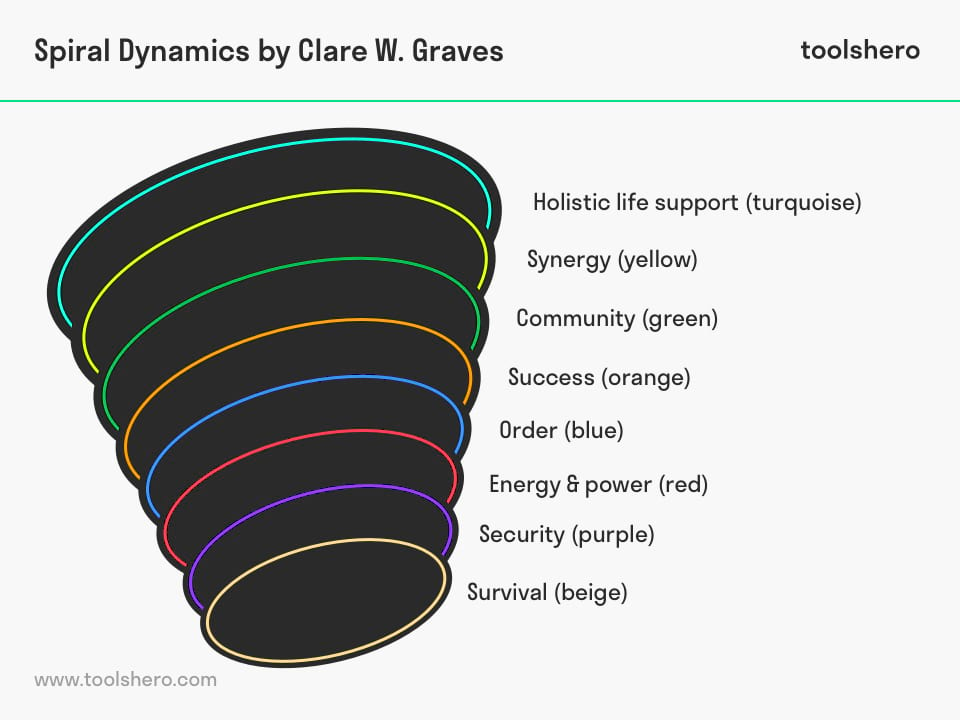Spiral Dynamics Theory (Graves)

Spiral Dynamics Theory: this article explains Spiral Dynamics Theory by Clare Graves in a practical way. It covers what Spiral Dynamics is, how it plays a role in change management and what the different stages and characteristics are. After reading it, you will understand the basics of this change management and behaviour tool. Enjoy reading!
What is Spiral Dynamics? The theory explained
Spiral Dynamics describes awareness development both at a personal and a collective level, such as organisations. It is based on the works of American Professor Emeritus of Psychology Clare W. Graves. Graves is also known for his double helix model.
The Spiral Dynamics Theory describes eight levels, expressed in value systems each with their own colours. These levels climb from simple structure to increasing complexity. Spiral Dynamics is a registered trademark and is mainly used in change management.
Spiral Dynamics Integral theory (SDi) is a pragmatic theoretical model for understanding the dynamic forces at work in human development and change processes. It is used by advisory agencies for personal development and organisational development. It was also used by Nelson Mandela in his fight against apartheid in South Africa.
Spiral Dynamics was initially worked out by Don Edward Beck and Christopher Cowan. It was later popularised by Ken Wilber.
Change and the Spiral Dynamics Theory
For companies, change is an important theme. Whether it is internal, by means of reorganisation, changing product group or other working methods; or whether it is external, with changing competition, markets or customers. Change is always present on the macro, meso and micro levels of organisations.
Many of these types of changes relate to people’s behaviour, and the behaviour of the employees in particular. Change in people takes place within certain personal boundaries. That is where Spiral Dynamics comes in.
Within those frameworks, it is people’s values that play a role; what do they think is important and what standards do they associate with these values? Spiral Dynamics focuses on the development of these values.
Spiral Dynamics: memes and genes
Spiral Dynamics makes use of the terms from ‘memetics’; the study of the evolution of culture and ideas. A meme is an idea that spreads itself through information carriers, such as the human brain. It is also described as a contagious information pattern.
Everyone is familiar with genes; the biological code carriers in human DNA. Biologist Richard Dawkins first introduced the term ‘memes’ in his book The Selfish Gene (1976). Genes underlie physical changes; they multiply themselves and move from cell to cell.
Memes are similar, they move from brain to brain. They are thought systems that spread themselves about society. Like viruses, they jump from mind to mind. Like genes, they form the human personality. As such, memes affect organisations and causes common thoughts. They may cause social conflicts, but they also provide solutions. They are the driving force behind new developments.
Values within the Spiral Dynamics Theory
In addition, according to professor Clare W. Graves, specific memes represent the attractive and repulsive forces behind the development of values. These are called value memes and within Spiral Dynamics they are used to identify value systems.
This determines how people think about certain things and why they believe in something. It is not about what they think. The value memes reveal the deeper value systems, on which people judge and evaluate observations.
Value systems in Spiral Dynamics
The value systems in Spiral Dynamics are colour coded. The first level of development is the simplest and from there it gets increasingly complex. Each value system has its own characteristic expression.

Figure 1 – The Colour Coded Value Systems of Spiral Dynamics.
Level 1 – survival (beige)
This is the first and also the lowest level of consciousness. It is the level of the group aimed at survival. It focuses on the necessary biological survival needs.
There are no individuals, people organise themselves according to herd behaviour. The strongest members are compassionate towards the weaker, protecting them and making the decisions. The rest follows. In situations of extreme stress or life threatening circumstances people can regress to this level.
Characteristics: people in this level hardly communicate. Everything that is communicated, focuses on survival (the primary necessities of life).
Level 2 – security (purple)
This is the level of the tribe: the close social unity in which people feel secure and, if necessary, will sacrifice themselves for the benefit of the group. This is the security that people seek and which is found in religion, for example. This level creates a social unit.
Characteristics: Communication takes place verbally from the high level to the lower level and vice versa. The leader speaks the truth and opposition is not tolerated.
Level 3 – energy & power (red)
This is the level of divide and conquer in which the hierarchical power structure is central. People are part of a system and are directed by the highest power-holder. All social relationships are power-oriented and occasionally a new order in hierarchy takes place.
Characteristics: Communication is purely top-down. There is continuous supervision of higher levels at lower levels. Orders are only effective if there are sanctions. Logic and persuasion are therefore not addressed.
Level 4 – order (blue)
This is the level of the conventional society, which establishes what is right and wrong. Established conventions and traditions are honoured and rules, procedures and structures are strictly adhered to. At this level, the concept of deferred reward occurs for the first time: if you do your best, you will be rewarded later.
Characteristics: Communication takes place from high to low and horizontally. The control freak needs to know what needs to be done. Consistent communication is very important. Intuition or feelings are unimportant
Level 5 – success (orange)
This is the ideal of the individualistic capitalist society. The truth lies in logical reasoning and (empirical) research, after which the correct conclusion is left. People perceive themselves as individuals.
In this level, everything revolves around success. Power equals prestige and position within the structure, which is acquired by successful operation.
Characteristics: Communication in this level takes place from high to low, low to high and horizontally. People are interested in each other and want to know whether it will positively impact their career. Communication is often focused on negotiation.
Level 6 – community (green)
Green is the level of humanity and the social network, in which man is interested in inner peace and peace with others. In this level, people attach great importance to their social environment and little to their own status.
People make decisions as a group, but each individual must be able to develop fully.
Characteristics: there is a lot of communication in all directions, where the emphasis is on reaching a consensus. There is also sensitivity to emotions and the needs of others.
Level 7 – synergy (yellow)
At this level, it is about system thinking; realising that everything is interconnected. Tolerance is the key word in this. People work together in a system in which they make their own decisions. This makes it possible to work on a project basis.
Characteristics: Communication takes place as needed, and it is important that information gets to the right place and is easily accessible. Think about management information systems.
Level 8 – holistic life support (turquoise)
This is the highest level. It is a holistic living system in which the world is seen as an interactive, interconnected system. At this level, energy is focused on sacrifice. Trust is put, not so much in a higher power, but in people. People are organising themselves in order to cherish and renew the world from macro level.
Characteristics: Communication is important in all layers; consensus and competence are merged for the benefit of the public good.
Now It’s Your Turn
What do you think? Do you recognize certain behaviour from the Value system of Spiral Dynamics model in your personal or professional environment? Do you recognize the practical explanation or do you have more suggestions? How do you deal with changes relate to people’s behaviour?
Share your experience and knowledge in the comments box below.
More information
- Burnes, B., & Jackson, P. (2011). Success and failure in organizational change: An exploration of the role of values. Journal of Change Management, 11(2), 133-162.
- Dawkins, R. (1976). The Selfish Gene. Oxford: Oxford University Press.
- Graves, C. W. (1970). Levels of existence: An open system theory of values. Journal of humanistic psychology, 10(2), 131-155.
How to cite this article:
Mulder, P. (2017). Spiral Dynamics Theory (Graves). Retrieved [insert date] from Toolshero: https://www.toolshero.com/change-management/spiral-dynamics/
Original publication date: 03/14/2018 | Last update: 08/25/2023
Add a link to this page on your website:
<a href=”https://www.toolshero.com/change-management/spiral-dynamics/”>Toolshero: Spiral Dynamics Theory (Graves)</a>













8 responses to “Spiral Dynamics Theory (Graves)”
I was reading book Conscious Capitalism and came across Spiral Dynamics study by professors Graves and Beck mentioned. Curious, I googled the topic and read a brief on it, Of course, i want to learn more about it, especially how it applies in political development. Am a retired information specialist and devt communicator. Used to work on development projects. Congrats!
Thank you for your comment and sharing your experience Ben. I am glad that you found the article helpful.
If you intend on inquiring more into spiral dynamics I highly recommend the video series on youtube by Actualized.org. It goes into detail about the limits of each stage and also incorporates a lot of examples that helps you really paint a picture of what it looks like in our world.
Thank you for your comment and sharing your experience George.
I am conducting research into Graves Model and have found very few scholarly articles dates 2011 tp present…any suggestions?
Tim, thank you for your comment. At this moment I don’t have any suggestions for you regarding the Graves Model. Maybe other readers? Anybody who can help Tim, please comment. Thank you in advance.
Spiral Dynamics book by Don Beck and Chris Cohen is the definitive colorized version offering extensive comments describing the levels, and discussions of entering and exiting a mimetic level
I first came across Spiral Dynamics on an NLP course in 2000, and think it’s an extremely useful framework. But there is so little written on it! I suspect this may have to do with how it is trade marked, which seems so orange – station orange, as my NLP teachers called it. I also suspect that even good people who talk about it may be kidding themselves; I recall someone who loved to boast she was coral, which I interpreted to mean she was blue-orange in fact…. Or a darling NLP researcher who likes to trash green and assumes he’s yellow; blue kinda wanting to do orange? I have learned it is best to assume you do not meet yellow very often, and it’s extremely unlikely you are yellow yourself unless you have already worked decades at working on your path with heart. (I am green. I would like to think not mean green, but.) I was introduced by a great individual to a twist on it when I worked in Australia, which included a variant of blue labelled Expert, which is just such a useful concept in working with engineers. But I don’t even know where that is written about.